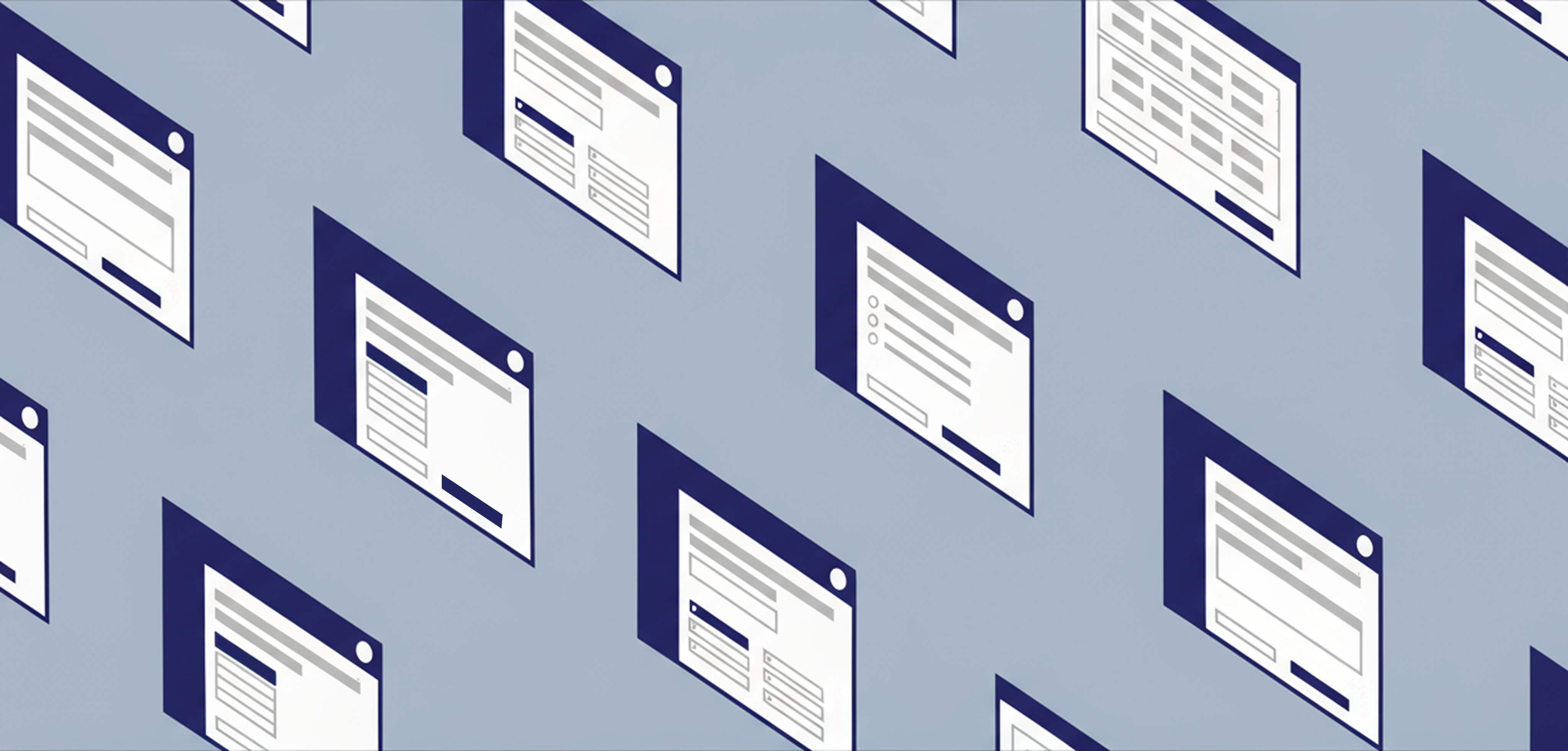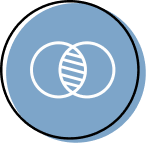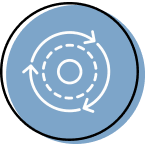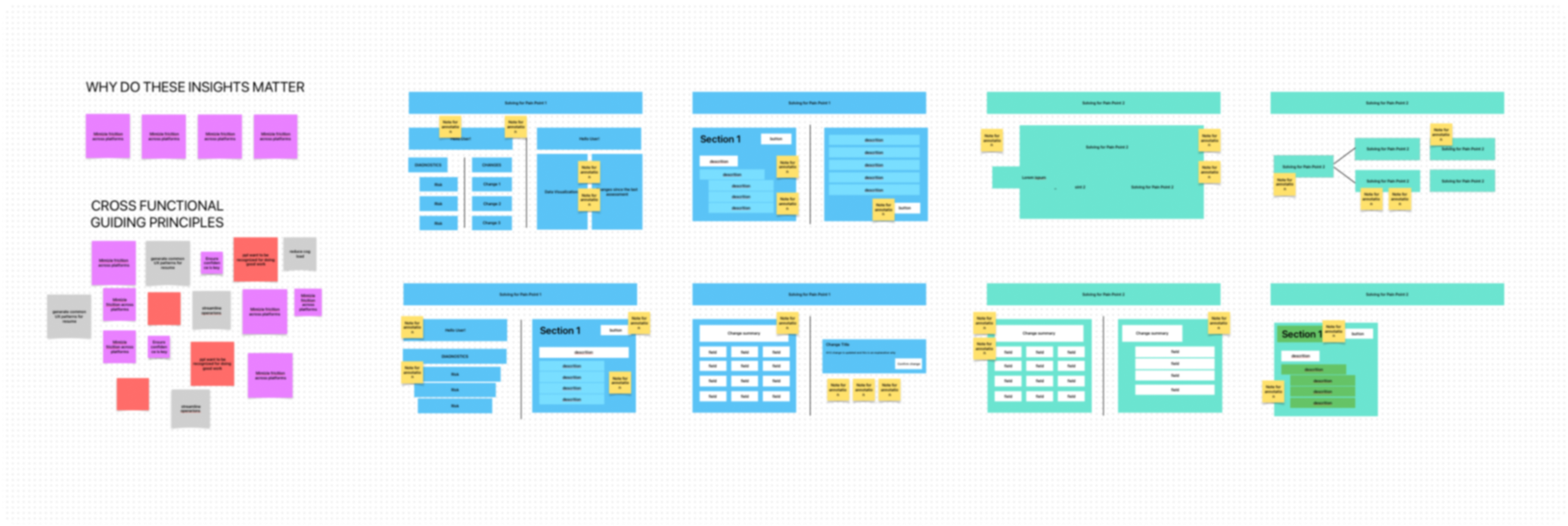Risk Assessments
Improving assessment activities through digital transformation, system aggregation, and capability optimization
project type.
Enterprise Experience
timeline.
12 weeks

project context.
A leading financial institution faced significant operational inefficiencies and high overhead costs due to a third-party CRM used for risk assessments. Our product team mitigated this business strain by migrating high value assessment capabilities and workflows into their in-house Governance, Risk, and Compliance (GRC) system where critical data for the assessment was housed.
This strategic decision afforded the business greater development control and substantial cost savings, and streamlined end-to-end operations for the system users.
key contributions.
Led the end-to-end design process from foundational discovery through final implementation
Close collaboration with product and tech partners to define scope and champion reusable strategic processes
Facilitated key conversations with executive leadership to align on product strategy and ensure parity with business goals.
applied skills.
UI Design • Design Research • Workshop Planning and Execution • Persona Development • Journey Mapping
solution overview .
The upgraded risk assessment experience is a fully integrated workflow built into an In-House GRC system, affording users a familiarity in look, and navigation to the core system where data relevant to the risk assessments in housed, intelligent guidance and recommendations across the workflow, as well as consistency in patterns and interaction design across the system and the workflow
understanding the business goals.
When onboarding to the engagement, our team partnered closely with our business partners to understand the business initiative, define our project constraints, and align on the scope of the work
clarity.
Prioritize system usability and clarity for users of various tenures
unity.

Minimize external and ad-hoc processes currently used in the wild
consistency.

Standardize operations and language across various assessment types
reusability.

Leverage and reuse patterns & Components from the core system
understanding the users needs.
Across the engagement, we conducted individual and group research sessions with a cohort of 100 internal users ranging from recently onboarded hires to seasoned veterans with over a decade of domain expertise.
We sought to better understand the user journeys and workflows within the current CRM Platform, areas of success and joy to preserve in the future state, irritations and frustrations to address in the future state, and desirable capabilities to explore
Driving Insights:
reduce clicks.
Users spent too much time navigating to high-value data. The design needed to be more direct
improve navigation.
The existing page hierarchy was confusing, making it difficult to find critical information quickly
humanize the language.
Icons and terminology lacked contextual support, creating a steep learning curve for new associates
explore automation.
Certain assessment actions can be system driven due to the migration of assessment capabilities
building empathy and alignment through collaborative design.
With the core insights defined, I facilitated a series of design jams using digital whiteboards to drive alignment on our core principles and ideate potential UX journey’s with our core product team.
This approach fostered empathy across the team and rapidly transformed user insights into directional sketches to refine product requirements and visualize tangible concepts

Across Ideation and Iteration, senior leadership and accountable executives were brought in frequently for strategic discussions and demonstrations on how the new experience would directly address business goals and user needs to secure buy-in.
cross-functional alignment .
At various stages of the design process, designs would be shared across our product, tech, and methodology partners to identify scope levers and areas of reuse with the core system we could pull to accelerate delivery.
This iterative process allowed us to validate solutions early and often, and ensured our designs remained technically feasible while addressing the needs of our users
handoff to implementation.
Progressively, designs were handed off to the development team to implement the new assessment experience into the GRC system
Detailed documentation was provided to ensure a smooth transition, and frequent touch bases (both ad-hoc and scheduled) ensured quality representation of our designs.
project impacts.
The redesign had a measurable and positive impact on both the business and our users
business Impacts.
$2 Mil/Year
estimated cost savings from sunsetting CRM system
Additionally consolidated maintenance from two systems into one, improving operational efficiency.
user impacts.
80%
Increase in positive NPS scores regarding redesigned ux
Eliminated communication latency by digitizing and centralizing a previously manual process
This project was a critical step in this institutions digital transformation journey, demonstrating how strategic design can deliver both significant business value and a superior user experience.
2025 PAVAN RADHAKRISHNAN
Risk Assessments
Improving assessment activities through digital transformation, system aggregation, and capability optimization
project type.
Enterprise Experience
timeline.
12 weeks

project context.
A leading financial institution faced significant operational inefficiencies and high overhead costs due to a third-party CRM used for risk assessments. Our product team mitigated this business strain by migrating high value assessment capabilities and workflows into their in-house Governance, Risk, and Compliance (GRC) system where critical data for the assessment was housed.
This strategic decision afforded the business greater development control and substantial cost savings, and streamlined end-to-end operations for the system users.
key contributions.
- Led the end-to-end design process from foundational discovery through final implementation
- Close collaboration with product and tech partners to define scope and champion reusable strategic processes
- Facilitated key conversations with executive leadership to align on product strategy and ensure parity with business goals.
applied skills.
UI Design • Design Research • Workshop Planning and Execution • Persona Development • Journey Mapping
solution overview .
The upgraded risk assessment experience is a fully integrated workflow built into an In-House GRC system, affording users a familiarity in look, and navigation to the core system where data relevant to the risk assessments in housed, intelligent guidance and recommendations across the workflow, as well as consistency in patterns and interaction design across the system and the workflow
understanding the business goals.
When onboarding to the engagement, our team partnered closely with our business partners to understand the business initiative, define our project constraints, and align on the scope of the work
clarity.
Prioritize system usability and clarity for users of various tenures
unity.

Minimize external and ad-hoc processes currently used in the wild
consistency.

Standardize operations and language across various assessment types
reusability.

Leverage and reuse patterns & Components from the core system
understanding the users needs.
Across the engagement, we conducted individual and group research sessions with a cohort of 100 internal users ranging from recently onboarded hires to seasoned veterans with over a decade of domain expertise.
We sought to better understand the user journeys and workflows within the current CRM Platform, areas of success and joy to preserve in the future state, irritations and frustrations to address in the future state, and desirable capabilities to explore
Driving Insights:
reduce clicks.
Users spent too much time navigating to high-value data. The design needed to be more direct
improve navigation.
The existing page hierarchy was confusing, making it difficult to find critical information quickly
humanize the language.
Icons and terminology lacked contextual support, creating a steep learning curve for new associates
explore automation.
Certain assessment actions can be system driven due to the migration of assessment capabilities
building empathy and alignment through collaborative design.
With the core insights defined, I facilitated a series of design jams using digital whiteboards to drive alignment on our core principles and ideate potential UX journey’s with our core product team.
This approach fostered empathy across the team and rapidly transformed user insights into directional sketches to refine product requirements and visualize tangible concepts

Across Ideation and Iteration, senior leadership and accountable executives were brought in frequently for strategic discussions and demonstrations on how the new experience would directly address business goals and user needs to secure buy-in.
cross-functional alignment .
At various stages of the design process, designs would be shared across our product, tech, and methodology partners to identify scope levers and areas of reuse with the core system we could pull to accelerate delivery.
This iterative process allowed us to validate solutions early and often, and ensured our designs remained technically feasible while addressing the needs of our users
handoff to implementation.
Progressively, designs were handed off to the development team to implement the new assessment experience into the GRC system
Detailed documentation was provided to ensure a smooth transition, and frequent touch bases (both ad-hoc and scheduled) ensured quality representation of our designs.
project impacts.
The redesign had a measurable and positive impact on both the business and our users
business Impacts.
$2 Mil/Year
estimated cost savings from sunsetting CRM system
Additionally consolidated maintenance from two systems into one, improving operational efficiency.
user impacts.
80%
Increase in positive NPS scores regarding redesigned ux
Eliminated communication latency by digitizing and centralizing a previously manual process
This project was a critical step in this institutions digital transformation journey, demonstrating how strategic design can deliver both significant business value and a superior user experience.
Risk Assessments
Improving assessment activities through digital transformation, system aggregation, and capability optimization
project type.
Enterprise Experience
timeline.
12 weeks

project context.
A leading financial institution faced significant operational inefficiencies and high overhead costs due to a third-party CRM used for risk assessments. Our product team mitigated this business strain by migrating high value assessment capabilities and workflows into their in-house Governance, Risk, and Compliance (GRC) system where critical data for the assessment was housed.
This strategic decision afforded the business greater development control and substantial cost savings, and streamlined end-to-end operations for the system users.
key contributions.
- Led the end-to-end design process from foundational discovery through final implementation
- Close collaboration with product and tech partners to define scope and champion reusable strategic processes
- Facilitated key conversations with executive leadership to align on product strategy and ensure parity with business goals.
applied skills.
UI Design • Design Research • Workshop Planning and Execution • Persona Development • Journey Mapping
solution overview .
The upgraded risk assessment experience is a fully integrated workflow built into an In-House GRC system, affording users a familiarity in look, and navigation to the core system where data relevant to the risk assessments in housed, intelligent guidance and recommendations across the workflow, as well as consistency in patterns and interaction design across the system and the workflow
understanding the business goals.
When onboarding to the engagement, our team partnered closely with our business partners to understand the business initiative, define our project constraints, and align on the scope of the work
clarity.
Prioritize system usability and clarity for users of various tenures
unity.

Minimize external and ad-hoc processes currently used in the wild
consistency.

Standardize operations and language across various assessment types
reusability.

Leverage and reuse patterns & Components from the core system
understanding the users needs.
Across the engagement, we conducted individual and group research sessions with a cohort of 100 internal users ranging from recently onboarded hires to seasoned veterans with over a decade of domain expertise.
We sought to better understand the user journeys and workflows within the current CRM Platform, areas of success and joy to preserve in the future state, irritations and frustrations to address in the future state, and desirable capabilities to explore
Driving Insights:
reduce clicks.
Users spent too much time navigating to high-value data. The design needed to be more direct
improve navigation.
The existing page hierarchy was confusing, making it difficult to find critical information quickly
humanize the language.
Icons and terminology lacked contextual support, creating a steep learning curve for new associates
explore automation.
Certain assessment actions can be system driven due to the migration of assessment capabilities
building empathy and alignment through collaborative design.
With the core insights defined, I facilitated a series of design jams using digital whiteboards to drive alignment on our core principles and ideate potential UX journey’s with our core product team.
This approach fostered empathy across the team and rapidly transformed user insights into directional sketches to refine product requirements and visualize tangible concepts

Across Ideation and Iteration, senior leadership and accountable executives were brought in frequently for strategic discussions and demonstrations on how the new experience would directly address business goals and user needs to secure buy-in.
cross-functional alignment .
At various stages of the design process, designs would be shared across our product, tech, and methodology partners to identify scope levers and areas of reuse with the core system we could pull to accelerate delivery.
This iterative process allowed us to validate solutions early and often, and ensured our designs remained technically feasible while addressing the needs of our users
handoff to implementation.
Progressively, designs were handed off to the development team to implement the new assessment experience into the GRC system
Detailed documentation was provided to ensure a smooth transition, and frequent touch bases (both ad-hoc and scheduled) ensured quality representation of our designs.
project impacts.
The redesign had a measurable and positive impact on both the business and our users
business Impacts.
$2 Mil/Year
estimated cost savings from sunsetting CRM system
Additionally consolidated maintenance from two systems into one, improving operational efficiency.
user impacts.
80%
Increase in positive NPS scores regarding redesigned ux
Eliminated communication latency by digitizing and centralizing a previously manual process
This project was a critical step in this institutions digital transformation journey, demonstrating how strategic design can deliver both significant business value and a superior user experience.